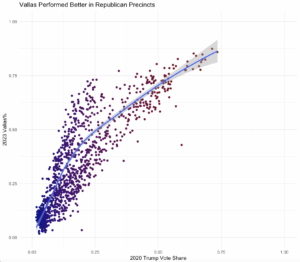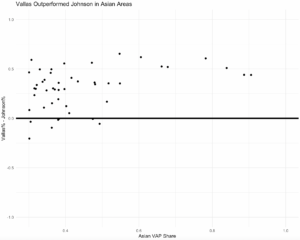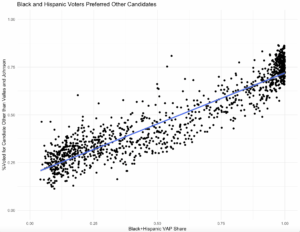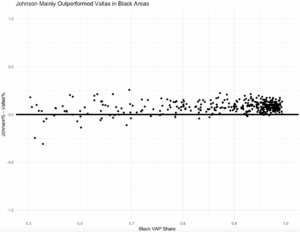With the general election only one day away, moderate Paul Vallas and progressive Brandon Johnson are locked in a dead heat. After the incumbent mayor, Lori Lightfoot, was eliminated in February’s Top-Two primary, Vallas and Johnson have had the stage to themselves as they try to appeal to a broader coalition of voters. While he did not come close to winning a majority of the vote, Vallas dominated the first round, earning ~33% of the vote compared to Johnson’s ~22%. He ran to the center of other candidates, focusing on the city’s growing crime issues. His politics and priorities clash with Johnson, who has campaigned with progressive icon Bernie Sanders and expressed a desire to “defund the police.”
Both Vallas and Johnson have realistic paths to winning Tuesday’s general election. Vallas handily defeated Johnson in the first round, won the only general election poll, and has a considerable spending advantage in the general election. However, Johnson has a higher ceiling among the electorate, given that he is running to the left of Vallas in a city where Biden won 83% of the vote. Vallas even accepted an endorsement from the Chicago Republican Party, while Johnson is backed by five Democrats who represent portions of Chicago in the US House. What will go down Tuesday night, and how can each candidate come out on top?
Vallas Will Dominate With Republican and Asian Voters
Although Chicago is extremely Democratic, Republicans still compose ~16% of the city’s voters. In the first round, they unsurprisingly backed Vallas, who had the support of the Chicago Republican Party. Republicans in Chicago predominantly live in the northwest and southwest corners of the city, near Midway and O’Hare Airports. Vallas’ support had a clear positive correlation with Trump’s vote share in the 2020 Presidential Election, as seen in the figure below.

While Asian voters only compose 8% of Chicago’s population, they could provide Vallas a much-needed boost over Johnson in a tight general election. Vallas won more of the vote than Johnson in 85% of Chicago’s 47 precincts where Asians are at least 30% of the total vote, by an average of ~31%.

Johnson Needs to Build Margin on the North Side
While Vallas performed well in some white and educated areas closer to the city center, such as in downtown Chicago and Lincoln Park, Johnson built up margins in less affluent areas to the west of the river and north of Wrigley Field. Given that Vallas performed close to his ceiling in these dark blue areas in the first round, Johnson should be set to gain as liberal Lightfoot and Garcia voters prefer his more progressive agenda and rhetoric. However, turnout may be an issue for Johnson, given early and absentee voting on the north side lagging behind areas where Vallas is stronger in the city’s periphery.
Vallas and Johnson Fight to Sway Uncomitted Black and Hispanic Voters
While most voters in white areas backed Vallas or Johnson in the first round, most voters in Hispanic and Black areas supported eliminated candidates such as Lightfoot, Chuy Garcia, or Willie Wilson. These minority-heavy areas have the most “free voters,” who voted in the first round but are looking for a new candidate to support after their first choice was eliminated. Turnout in these areas should be relatively low, given voters’ top choices were more likely to have been eliminated.

For Johnson to defeat Vallas, he must win substantially more “free voters” from these areas. In the first round, Johnson outran Vallas with voters in majority Black areas but lagged behind him in majority Hispanic areas.


Summary
The math problem for Johnson is simple; he has to make an ~11% margin by increasing his base turnout and winning more “free voters” than Vallas. Making some rudimentary assumptions (the same voters turn out in the second round as the first round and all Johnson and Vallas voters support the same candidate), Johnson has to win 62% of free voters to catch Vallas.